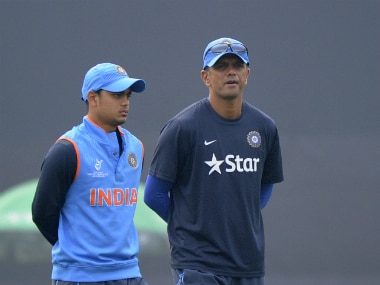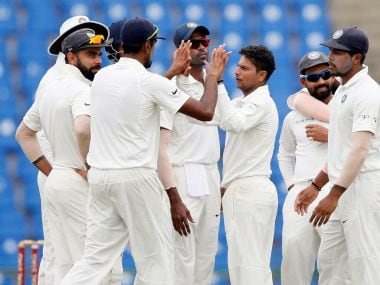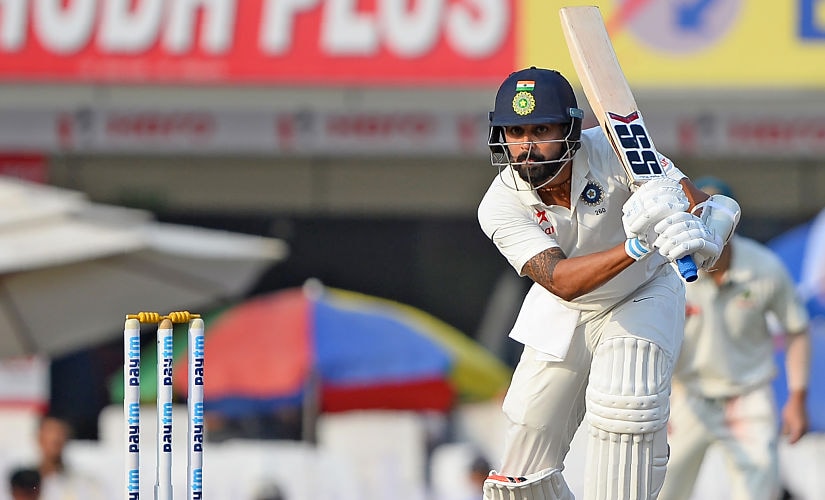Ellyse Perry's double ton a shot in the arm for women's cricket, but quality of pitch leaves a lot to be desired
For cricket to be a theatre, the thrills of wickets falling rapidly and runs being scored at a brisk pace are paramount. The attrition, grind, and patience displayed by the ladies is a testimony to their skills, but the modern world demands the game to move at rapid rate.
Gaurav Joshi, Nov, 13 2017
- New Zealand in India, 3 T20 International Series, 2017 IND Vs NZ India beat New Zealand by 6 runs
- New Zealand in India, 3 T20 International Series, 2017 IND Vs NZ New Zealand beat India by 40 runs
- New Zealand in India, 3 T20 International Series, 2017 IND Vs NZ India beat New Zealand by 53 runs
- Pakistan and Sri Lanka in UAE, 3 T20 International Series, 2017 PAK Vs SL Pakistan beat Sri Lanka by 36 runs
- Bangladesh in South Africa, 2 T20 International Series, 2017 SA Vs BAN South Africa beat Bangladesh by 83 runs
- Sri Lanka in India, 3 Test Series, 2017 IND vs SL - Nov 16th, 2017, 09:30 AM IST
- The Ashes, 2017/18 AUS vs ENG - Nov 23rd, 2017, 05:30 AM IST
- Sri Lanka in India, 3 Test Series, 2017 IND vs SL - Nov 24th, 2017, 09:30 AM IST
- Papua New Guinea and Scotland in UAE, 2 ODI Series, 2017 PNG vs SCO - Nov 24th, 2017, 04:30 PM IST
- Papua New Guinea and Scotland in UAE, 2 ODI Series, 2017 PNG vs SCO - Nov 25th, 2017, 04:30 PM IST
| Rank | Team | Points | Rating |
|---|---|---|---|
| 1 | India | 4493 | 125 |
| 2 | South Africa | 3767 | 111 |
| 3 | England | 4497 | 105 |
| 4 | New Zealand | 3114 | 97 |
| 5 | Australia | 3294 | 97 |
| Rank | Team | Points | Rating |
|---|---|---|---|
| 1 | South Africa | 6386 | 120 |
| 2 | India | 6379 | 120 |
| 3 | Australia | 5948 | 114 |
| 4 | England | 6156 | 114 |
| 5 | New Zealand | 5432 | 111 |
| Rank | Team | Points | Rating |
|---|---|---|---|
| 1 | Pakistan | 2843 | 124 |
| 2 | New Zealand | 1925 | 120 |
| 3 | West Indies | 2395 | 120 |
| 4 | England | 2029 | 119 |
| 5 | India | 2965 | 119 |





Sydney: The setting could not have been more ideal for the inaugural day-night Women’s Ashes Test match. The picturesque North Sydney Oval along with city’s perfect spring attracted 12,674 fans over the course of four days. Credit must be given to Cricket Australia on the timing of the event. They had marketed, advertised and sold the Women’s Ashes Test as part of the package of men’s Ashes starting next week. From a spectator and viewership point of view, the Test match can be termed a relative success.
On the field, it took a superb double century from superwoman Ellyse Perry on the third evening to bring the Test to life. Perry, the multi-sport athlete, has won two cricket World Cups (2010 World T20 and 2013 World Cup), and scored a goal for Australia at the football World Cup (against Sweden in 2011), but she rated the atmosphere at the North Sydney Oval as one of the great thrills in her career. That statement is a definite tick in the box for the organisers.
File photo of Ellyse Perry (L) with the Australian team. Reuters
However, with all the good comes the bad. Cricket Australia achieved the major goal of making the Test match a great spectacle and bringing fans, but the quality of the pitch rolled out for this historic event nullified the rapid rise of women’s skills in cricket. For cricket to be a theatre, the thrills of wickets falling rapidly and runs being scored at a brisk pace are paramount. The attrition, grind, and patience displayed by the ladies is a testimony to their skills, but the modern world demands the game to move at rapid rate.
It is by no means the players' fault; Perry’s double century was a masterclass and Amanda Jade-Wellington's delivery that castled England opener Tammy Beaumont reminded one of the famous Shane Warne ball to Mike Gatting. The players needed more response from a fruitless pitch.
At the end of it all, the crowd left a bit disappointed, not with the concept of the Women’s day-night Ashes fixture, but more so for the fact that the game concluded in such a lacklustre way with both teams agreeing for a draw an hour before the scheduled close of play.
For four days, a large proportion of young females sat patiently on the hill, eating their ice-creams before wrapping themselves in blankets as the lights took over and the temperatures took a dip, with eyes still fixed on the action in the middle. Many of them lined the fence for autographs, and surprisingly, could identify the Australian players.
One of the key strategies that ensured the event was a success was to play the match as a day-night affair and to host it as the North Sydney Oval instead of the traditional Sydney Cricket Ground. The benefit of playing it at North Sydney Oval is that the iconic ground sits right alongside a series of commercial buildings that employ close to 50,000 people. At dusk, the crowd doubled on the first two nights as most of the professionals dressed in suits, or in their business attire, sat peacefully on the grass banks with their kids, enjoying the serenity and the cricketing action.
Martin Blair, an economist at finance giant Zurich Insurance, told Firstpost, “It is fantastic to be able to watch Australia play in a Test match at a suburban ground that is so easily accessible. To be fair, we would love to see the more sixes towards us, but the setting makes up for it.”
For the first two days the cricket might have been slightly dour. England and Australia scoring at a combined run-rate of 2.6 runs-an-over is hardly thrilling. But never did a spectator mouth the famous Australian slogans such as “get on with it” or ‘have a go, you mug” that are common during a dull period during a Test match or even a 50-over game.
It wasn’t until the late third afternoon, when Perry closed in on a century, did the crowd become really vociferous. The appreciation as Perry reached the three-figure mark was a sight to behold; close to 5000 spectators rose at once to offer rapturous applause saved for the likes Bradman, Benaud, Warne, McGrath, Ponting and Warner. Perhaps, that was the moment that resembled the success of the match.
By the time Perry pushed her way towards 150 and the sun set behind the Mollie Dive stand, a couple more thousand had passed through the gates. Saturday night with Australia on top of the old rival was ideal for the crowd. The ground was close to 60% full; without doubt a brilliant advertisement for women’s cricket. Cricket Australia and the women’s game had succeeded in gathering interest of the Australian public.
But perhaps the most symbolic moment was the manner in which over 200 spectators, mostly young girls, lined up at the picket fence outside the dressing room waiting for autographs and pictures. Every night at the conclusion of play, the ecstatic girls posed for photos with their heroes.
Apart from the docile pitch, the event itself was received with open arms and appreciated by young and old. A more conducive pitch would have ensured more entertainment, more wickets and possibly a thrilling finish. In an age when Test cricket for men is on the decline, it was imminent that all the attributes had lined up to make the Women's Test an immense success. However, for that ‘I was there’ moment to happen, the event lacked support of the ground staff.
The rise of the Women's Big Bash League (WBBL) in recent times has made it apparent that the skills are definitely there in abundance, but women need a surface that encourages a brand of cricket that will make the game even more entertaining.
The day-night Women’s Test definitely has a future as long as they are not overdone. It needs a context, like the Ashes. With the women’s game on the rise in India and with Indian men scheduled to tour Down Under next year, it is definitely worth staging another Test match sometime soon.
Published Date:Nov 13, 2017
| Updated Date: Nov 13, 2017
Also See
Ashes 2017-18: England pacer Jake Ball injures ankle in clash against Cricket Australia XI ahead of 1st Test
Ashes 2017: England pacer James Anderson says he is open to replacing Ben Stokes as vice-captain for the series
Ellyse Perry's long-awaited maiden international century has potential to resurrect women's Test cricket